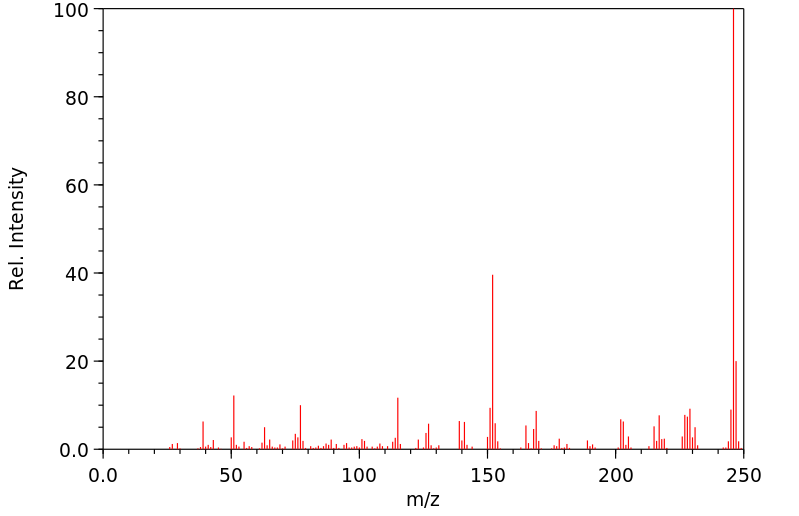苯氧基-1,1'-联苯 | 6738-04-1
中文名称
苯氧基-1,1'-联苯
中文别名
1,3-双(二苯基膦)丙烷;2-苯氧基联苯基, 98+%;2-苯氧基联苯, 98+%;2-苯氧基联苯基;2-苯氧基联苯
英文名称
2-phenoxy-1,1'-biphenyl
英文别名
2-phenoxybiphenyl;2-phenyl-diphenyl ether;o-biphenylyl phenyl ether;1-phenoxy-2-phenylbenzene
CAS
6738-04-1;28984-89-6
化学式
C18H14O
mdl
MFCD00003035
分子量
246.309
InChiKey
UHJWZORSTYATLW-UHFFFAOYSA-N
BEILSTEIN
——
EINECS
——
-
物化性质
-
计算性质
-
ADMET
-
安全信息
-
SDS
-
制备方法与用途
-
上下游信息
-
文献信息
-
表征谱图
-
同类化合物
-
相关功能分类
-
相关结构分类
物化性质
-
熔点:48-50°C
-
沸点:200-201 °C
-
密度:1.093
计算性质
-
辛醇/水分配系数(LogP):4.8
-
重原子数:19
-
可旋转键数:3
-
环数:3.0
-
sp3杂化的碳原子比例:0.0
-
拓扑面积:9.2
-
氢给体数:0
-
氢受体数:1
安全信息
-
安全说明:S22,S24/25
-
海关编码:2909309090
SDS
上下游信息
反应信息
-
作为反应物:描述:参考文献:名称:Luettringhaus; v. Saeaef, Justus Liebigs Annalen der Chemie, 1939, vol. 542, p. 241,257摘要:DOI:
-
作为产物:描述:参考文献:名称:TMP-碘鎓 (III) 乙酸盐的配体和抗衡离子辅助苯酚 O-芳基化摘要:实现了三甲氧基苯基 (TMP)-碘鎓 (III) 乙酸酯对苯酚O-芳基化的高反应性。首先确定 TMP 配体和乙酸根阴离子协同增强对苯酚氧原子的亲电反应性。与先前报道的技术相比,所提出的方法以显着更高的产率提供了获得各种二芳基醚的途径。在O-芳基化过程中可以耐受各种官能团,包括脂肪醇、硼酸酯和空间位阻基团,验证了这种配体和抗衡离子辅助策略的适用性。DOI:10.1021/acs.orglett.2c00294
文献信息
-
The Suzuki–Miyaura Coupling of Nitroarenes作者:M. Ramu Yadav、Masahiro Nagaoka、Myuto Kashihara、Rong-Lin Zhong、Takanori Miyazaki、Shigeyoshi Sakaki、Yoshiaki NakaoDOI:10.1021/jacs.7b03159日期:2017.7.19Synthesis of biaryls via the Suzuki-Miyaura coupling (SMC) reaction using nitroarenes as an electrophilic coupling partners is described. Mechanistic studies have revealed that the catalytic cycle of this reaction is initiated by the cleavage of the aryl-nitro (Ar-NO2) bond by palladium, which represents an unprecedented elemental reaction.
-
Competing Pathways in O-Arylations with Diaryliodonium Salts: Mechanistic Insights作者:Elin Stridfeldt、Erik Lindstedt、Marcus Reitti、Jan Blid、Per-Ola Norrby、Berit OlofssonDOI:10.1002/chem.201703057日期:2017.9.21Put a ring on it! The arylation of aliphatic alcohols and hydroxide with diaryliodonium salts, to give alkyl aryl ethers and diaryl ethers, has been studied using experimental techniques and DFT calculations. Aryne formation and alcohol oxidation pathways were observed in parallel to arylation, and additives to avoid by-product formation originating from arynes have been found. A novel, direct nucleophilic
-
Metal- and ligand-free Ullmann-type C–O and C–N coupling reactions promoted by potassium tert-butoxide作者:Shuliang Yang、Cunqi Wu、Mingbo Ruan、Yanqin Yang、Yongxia Zhao、Jiajia Niu、Wei Yang、Jingwei XuDOI:10.1016/j.tetlet.2012.05.131日期:2012.8A simple, metal- and ligand-free procedure for the Ullmann-type C–O coupling reactions has been achieved by allowing aryl bromides to react with a variety of phenols in the presence of t-BuOK. Moderate to excellent yields of O-arylation products are obtained under mild conditions in a short time. In addition, two examples of C–N coupling reactions are also reported. A benzyne mechanism is proposed
-
Diaryl Ether Formation Merging Photoredox and Nickel Catalysis作者:Le Liu、Cristina NevadoDOI:10.1021/acs.organomet.1c00018日期:2021.7.26Photoredox and Ni catalysis are combined to produce diaryl ethers under mild conditions. A broad range of aryl halides and phenol derivatives are cross-coupled in the presence of a readily available organic photocatalyst and NiBr2(dtbpy). Symmetrical diaryl ethers have also been directly obtained from aryl bromides in the presence of water. Mechanistic investigations support the involvement of Ni(0)
-
Reactions of Selenurane [10-Se-4 (C4)] with Alcohols, Thiols and Selenol. A Quest for Formation of a New a-Selenurane [10-Se-4 (C3O)], [10-Se-4 (C3S)] or [10-Se-4 (C3Se)]作者:Soichi Sato、Naomichi FurukawaDOI:10.1246/cl.1994.889日期:1994.5Bis(2,2′-biphenylylene)selenurane readily reacts with various alcohols, phenols, thiols and selenol to give ligand coupling or ipso-substitution products under mild conditions via a two-step mechanism involving a σ-selenurane [10-Se-4 (C3O)], [10-Se-4 (C3S)] and [10-Se-4 (C3Se)] or corresponding selenonium salts as intermediates.
表征谱图
-
氢谱1HNMR
-
质谱MS
-
碳谱13CNMR
-
红外IR
-
拉曼Raman
-
峰位数据
-
峰位匹配
-
表征信息
同类化合物
(βS)-β-氨基-4-(4-羟基苯氧基)-3,5-二碘苯甲丙醇
(S,S)-邻甲苯基-DIPAMP
(S)-(-)-7'-〔4(S)-(苄基)恶唑-2-基]-7-二(3,5-二-叔丁基苯基)膦基-2,2',3,3'-四氢-1,1-螺二氢茚
(S)-盐酸沙丁胺醇
(S)-3-(叔丁基)-4-(2,6-二甲氧基苯基)-2,3-二氢苯并[d][1,3]氧磷杂环戊二烯
(S)-2,2'-双[双(3,5-三氟甲基苯基)膦基]-4,4',6,6'-四甲氧基联苯
(S)-1-[3,5-双(三氟甲基)苯基]-3-[1-(二甲基氨基)-3-甲基丁烷-2-基]硫脲
(R)富马酸托特罗定
(R)-(-)-盐酸尼古地平
(R)-(-)-4,12-双(二苯基膦基)[2.2]对环芳烷(1,5环辛二烯)铑(I)四氟硼酸盐
(R)-(+)-7-双(3,5-二叔丁基苯基)膦基7''-[((6-甲基吡啶-2-基甲基)氨基]-2,2'',3,3''-四氢-1,1''-螺双茚满
(R)-(+)-7-双(3,5-二叔丁基苯基)膦基7''-[(4-叔丁基吡啶-2-基甲基)氨基]-2,2'',3,3''-四氢-1,1''-螺双茚满
(R)-(+)-7-双(3,5-二叔丁基苯基)膦基7''-[(3-甲基吡啶-2-基甲基)氨基]-2,2'',3,3''-四氢-1,1''-螺双茚满
(R)-(+)-4,7-双(3,5-二-叔丁基苯基)膦基-7“-[(吡啶-2-基甲基)氨基]-2,2”,3,3'-四氢1,1'-螺二茚满
(R)-3-(叔丁基)-4-(2,6-二苯氧基苯基)-2,3-二氢苯并[d][1,3]氧杂磷杂环戊烯
(R)-2-[((二苯基膦基)甲基]吡咯烷
(R)-1-[3,5-双(三氟甲基)苯基]-3-[1-(二甲基氨基)-3-甲基丁烷-2-基]硫脲
(N-(4-甲氧基苯基)-N-甲基-3-(1-哌啶基)丙-2-烯酰胺)
(5-溴-2-羟基苯基)-4-氯苯甲酮
(5-溴-2-氯苯基)(4-羟基苯基)甲酮
(5-氧代-3-苯基-2,5-二氢-1,2,3,4-oxatriazol-3-鎓)
(4S,5R)-4-甲基-5-苯基-1,2,3-氧代噻唑烷-2,2-二氧化物-3-羧酸叔丁酯
(4S,4''S)-2,2''-亚环戊基双[4,5-二氢-4-(苯甲基)恶唑]
(4-溴苯基)-[2-氟-4-[6-[甲基(丙-2-烯基)氨基]己氧基]苯基]甲酮
(4-丁氧基苯甲基)三苯基溴化磷
(3aR,8aR)-(-)-4,4,8,8-四(3,5-二甲基苯基)四氢-2,2-二甲基-6-苯基-1,3-二氧戊环[4,5-e]二恶唑磷
(3aR,6aS)-5-氧代六氢环戊基[c]吡咯-2(1H)-羧酸酯
(2Z)-3-[[(4-氯苯基)氨基]-2-氰基丙烯酸乙酯
(2S,3S,5S)-5-(叔丁氧基甲酰氨基)-2-(N-5-噻唑基-甲氧羰基)氨基-1,6-二苯基-3-羟基己烷
(2S,2''S,3S,3''S)-3,3''-二叔丁基-4,4''-双(2,6-二甲氧基苯基)-2,2'',3,3''-四氢-2,2''-联苯并[d][1,3]氧杂磷杂戊环
(2S)-(-)-2-{[[[[3,5-双(氟代甲基)苯基]氨基]硫代甲基]氨基}-N-(二苯基甲基)-N,3,3-三甲基丁酰胺
(2S)-2-[[[[[((1S,2S)-2-氨基环己基]氨基]硫代甲基]氨基]-N-(二苯甲基)-N,3,3-三甲基丁酰胺
(2S)-2-[[[[[[((1R,2R)-2-氨基环己基]氨基]硫代甲基]氨基]-N-(二苯甲基)-N,3,3-三甲基丁酰胺
(2-硝基苯基)磷酸三酰胺
(2,6-二氯苯基)乙酰氯
(2,3-二甲氧基-5-甲基苯基)硼酸
(1S,2S,3S,5S)-5-叠氮基-3-(苯基甲氧基)-2-[(苯基甲氧基)甲基]环戊醇
(1S,2S,3R,5R)-2-(苄氧基)甲基-6-氧杂双环[3.1.0]己-3-醇
(1-(4-氟苯基)环丙基)甲胺盐酸盐
(1-(3-溴苯基)环丁基)甲胺盐酸盐
(1-(2-氯苯基)环丁基)甲胺盐酸盐
(1-(2-氟苯基)环丙基)甲胺盐酸盐
(1-(2,6-二氟苯基)环丙基)甲胺盐酸盐
(-)-去甲基西布曲明
龙蒿油
龙胆酸钠
龙胆酸叔丁酯
龙胆酸
龙胆紫-d6
龙胆紫







